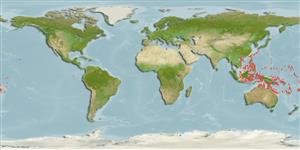Common names from other countries
>
Eupercaria/misc (Various families in series Eupercaria) >
Scaridae (Parrotfishes) > Scarinae
Etymology: Scarus: Greek, skaros = a fish described by anciente writers as a parrot fish; 1601 (Ref. 45335).
More on author: Bleeker.
Environment: milieu / climate zone / depth range / distribution range
Ecologia
marinhas; estuarina associadas(os) a recifes; intervalo de profundidade 1 - 25 m (Ref. 90102). Tropical; 30°N - 24°S, 107°E - 170°W
Western Pacific: Indonesia to Samoa, north to the Ryukyu Islands, south to the Great Barrier Reef. Replaced by Scarus scaber in the Indian Ocean (Ref. 37816).
Tamanho / Peso / Idade
Maturity: Lm ? range ? - ? cm
Max length : 40.0 cm TL macho/indeterminado; (Ref. 48636)
Espinhos dorsais (total): 9; Raios dorsais moles (total): 10; Espinhos anais 3; Raios anais moles: 9. Males recognized by the blue snout and band behind eye. Eastern form has blue cheek and western form has yellow cheek. Females grey to yellow with dusky saddle over back (Ref. 48636). Closely resembles S. oviceps and S. scaber. In S. oviceps, the initial phase has fewer, less vertical diagonal dark bars on the back and the terminal phase lacks the light-centered bar between the eye and the pectoral fin base, is darker and less brilliant blue on the upper head and back, and is usually larger.
Inhabits coral-rich areas of clear, protected reefs (Ref. 9710). Found in lagoon and seaward reefs (Ref. 90102). Feeds mainly on algae (Ref. 26993).
Life cycle and mating behavior
Maturidade | Reprodução | Desova | Ovos | Fecundidade | Larvas
Oviparous, distinct pairing during breeding (Ref. 205).
Parenti, P. and J.E. Randall, 2000. An annotated checklist of the species of the labroid fish families Labridae and Scaridae. Ichthyol. Bull. J.L.B. Smith Inst. Ichthyol. (68):1-97. (Ref. 35918)
Categoria na Lista Vermelha da IUCN (Ref. 130435)
CITES (Ref. 128078)
Not Evaluated
Ameaça para o homem
Harmless
Utilização humana
Pescarias: espécies comerciais; Aquário: Espécies comerciais
Mais informação
ReferênciasAquaculturaPerfil para aquaculturaEstirpesGenéticaElectrophoresesHereditariedadeDoençasProcessamentoMass conversion
ColaboradoresFotografiasStamps, Coins Misc.SonsCiguateraVelocidadeTipo de nataçãoÁrea branquialOutras referênciasCérebrosVisão
Ferramentas
Relatórios especiais
Descarregue XML
Fontes da internet
Estimates based on models
Preferred temperature (Ref.
115969): 25.2 - 29.3, mean 28.5 (based on 1649 cells).
Phylogenetic diversity index (Ref.
82804): PD
50 = 0.5000 [Uniqueness, from 0.5 = low to 2.0 = high].
Bayesian length-weight: a=0.01380 (0.00789 - 0.02416), b=3.13 (2.97 - 3.29), in cm Total Length, based on LWR estimates for this species & Genus-body shape (Ref.
93245).
Nível Trófico (Ref.
69278): 2.0 ±0.00 se; based on food items.
Resiliência (Ref.
120179): Elevada, tempo mínimo de duplicação da população menor que 15 meses (Preliminary K or Fecundity.).
Fishing Vulnerability (Ref.
59153): Low to moderate vulnerability (30 of 100).
